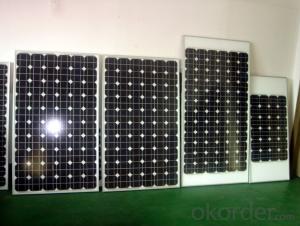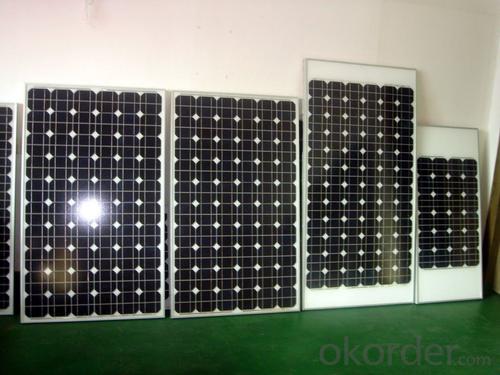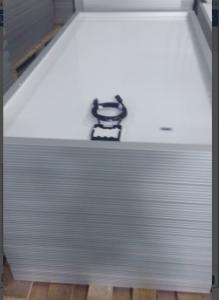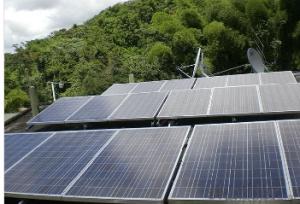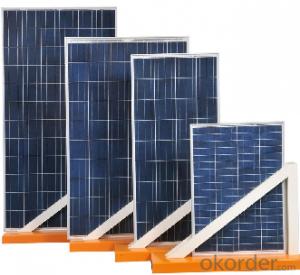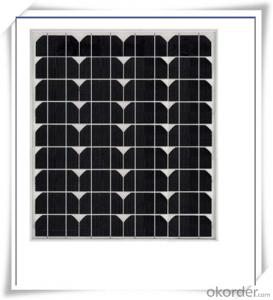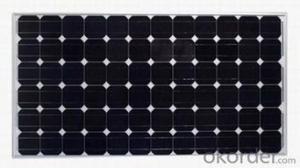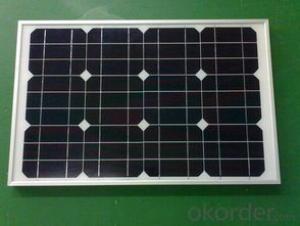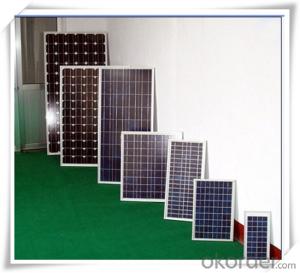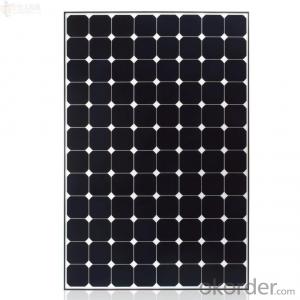High Quality 1.5w to 180w Monocrystalline Solar Panels Iran CNBM
- Loading Port:
- Qingdao
- Payment Terms:
- TT OR LC
- Min Order Qty:
- 10 set
- Supply Capability:
- 300000 set/month
OKorder Service Pledge
OKorder Financial Service
You Might Also Like
1.5W to 180W Monocrystalline Solar Panel
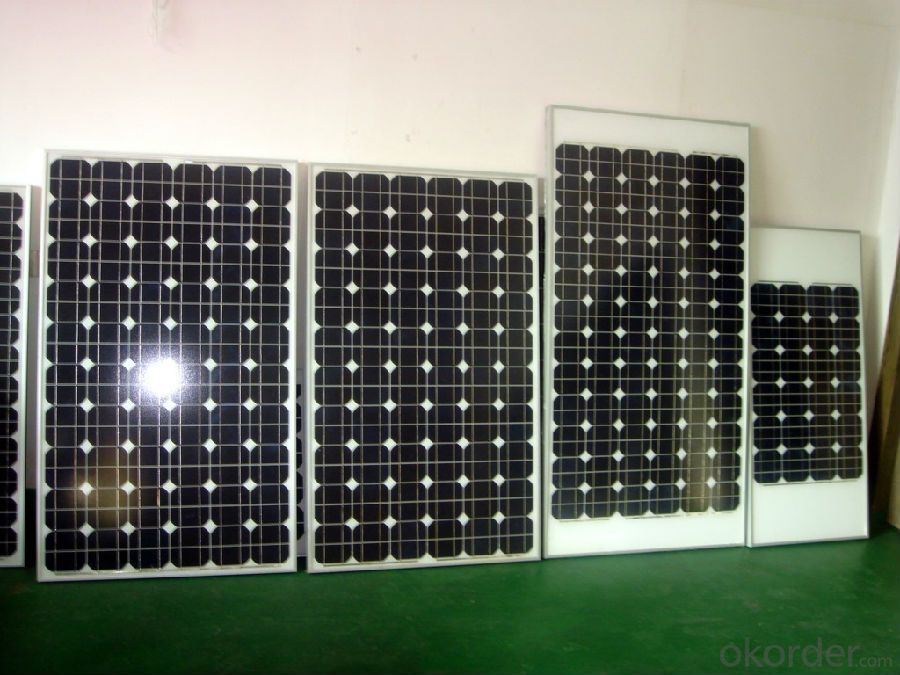
Quick Details
Place of Origin: | China (Mainland) | Brand Name: | CNBM | Model Number: | XRP-156M-250W |
Material: | Monocrystalline Silicon | Size: | 1620x992x40mm | Number of Cells: | 60 |
Max. Power: | 250w | Optimum Operating Voltage (Vmp): | 28.8V | Optimum Operating Current (Imp): | 8.68A |
Open Circuit Voltage (Voc): | 36V | Short Circuit Current (Isc): | 8.87A | Maximum Power at STC (Pmax): | 250W |
Operating Module Temperature: | -40 °C to +85 °C | Maximum System Voltage: | 1000 V DC (IEC) / 600V DC (UL) | Maximum Series Fuse Rating: | 15A |
Packaging & Delivery
Delivery Detail: | two weeks after order confirmation |
Features:
1) High Module conversion efficiency, through superior manufacturing technology
2) 0 to +5W positive tolerance for mainstream products
3) Certified to withstand high wind loads and snow loads
4) Anodized aluminum is for improving corrosion resistance
5) Anti-reflective, Highly transparent, low iron tempered glass
6) Excellent performance under low light environment
Benefit:
25-year performance warrant
10-year Product warranty
Electrical Characteristics:
Item No. | XRM-250W |
Optimum Operating Voltage (Vmp) | 28.8V |
Optimum Operating Current (Imp) | 8.68A |
Open Circuit Voltage (Voc) | 36V |
Short Circuit Current (Isc) | 8.87A |
Maximum Power at STC (Pmax) | 250W |
Cell Efficiency | 17.70% |
Operating Module Temperature | -40 °C to +85 °C |
Maximum System Voltage | 1000 V DC (IEC) / 600V DC (UL) |
Maximum Series Fuse Rating | 15A |
Power Tolerance | 0/+5 % |
STC: lrradiance 1000 W/m2, module temperature 25 °C, AM=1.5;
Best in Class AAA solar simulator (IEC 60904-9) used, power measurement uncertainty is within +/- 3%
Mechanical Characteristics:
No. of Cells | 60(6X10) |
Dimensions | 1640x992x40MM |
Weight | 20.0KGS |
Front | Glass 4.0 mm tempered glass |
Frame | Anodized aluminium alloy |
Temperature Characteristics:
Nominal Operating Cell Temperature (NOCT) | 45±2°C |
Temperature Coefficient of Pmax | -0.44 %/°C |
Temperature Coefficient of Voc | -0.33 %/°C |
Temperature Coefficient of Isc | 0.055 %/°C |
Refer to the Wmp range
Our factory can produce solar panel and solar module from 1.5W-290w (1.5w, 2.5w, 5w, 10w, 20w, 40w, 50w, 60w, 80w, 85w, 125w, 135w, 150w, 165w, 180w), according to customers requirement.
(A). Wmp range: 0.01W-6W, to be sealed with epoxy resin on PCB (printed circuit board), or to be sealed in plastic directly.
(B). Wmp range: 0.01W-15W, to be encapsulated with PET, on PCB (printed circuit board)
(C). Wmp range: 1W-60W, to be encapsulated with PET, on stainless steel, with holes for assembling purpose.
(D). Wmp range: 1W-290W, to be encapsulated with tempered glass, EVA, TPT, together with aluminium frame, junction box and (if necessary)diode and cable.
Refer to the material:
Monocrystalline solar cell or polycrystalline solar cell
Efficiency range 14%-17%, cell size 5/6.
- Q: What is the impact of hailstorms on solar panels?
- Hailstorms can potentially cause damage to solar panels, particularly if the hailstones are large and the panels are not adequately protected. The impact can range from minor scratches and dents, which may not affect the overall performance of the panels, to more severe damage that can impair their functionality. However, advancements in technology and the use of durable materials have made modern solar panels more resistant to hail damage. Proper installation and maintenance, including the use of protective measures like tempered glass or hail guards, can further minimize the impact of hailstorms on solar panels.
- Q: Can solar panels be installed on flat surfaces?
- Yes, solar panels can be installed on flat surfaces. While it is more common to install solar panels on angled surfaces or rooftops to optimize their exposure to sunlight, flat surfaces can also be used. In such cases, mounting systems or support structures are used to tilt the panels at an angle that maximizes their efficiency.
- Q: If I wanted to add solar panels to my home to produce on average, 8 kWh of electricity daily, how much do you estimate it would cost using state of the art technology?I live in Virginia (Washington DC Metro Area), and I have Dominion Power. I pay the following electric rates:Jun-Sep $0.0904/kWhOct-May $0.0776/kWhAnnual Ave: $0.0824/kWhDistribution charges add on approximately another $0.0228/kWh.How long would the ROI for an 8 kWh/day solar system be?
- Figure 8 hours of sun per day, so 8 kW-hr is a rate of kW, which is a medium sized panel, probably not enough to operate your house totally, unless you have a very small unit. Averaged over 24 hours, that is power at a rate of only 300 watts, enough for a TV. Average US home use is .2 kW, which over 24 hours is 29 kW-hr, plus you need extra for cloudy days, peak demands, and to charge batteries. You have to decide off-grid or on-grid, and if you want to (and are allowed to) sell excess power to the power company. Off gird, the cost of batteries and charge controller are a large part of the cost. On-grid, you have to purchase equipment approved by the power company to match your power with the grid. Panels will cost about $3 per watt, so for 000 watts that is $3000. Double that for installation, then add in cost of charge controller, inverter, batteries, etc. The last items depend on your alternatives, see paragraph above. .
- Q: I recently got into solar panels, I have little background in electronics but I have done a little electrical work in the past and just want to make a small 36 cell panel to power a 2v battery that would run my a small tv (9 inch) and PS3 for a few hours every night. I have been looking up on how to do it before I get in over my head and I have a few questions.... After you solder all of the cells together then what? Do you hook all of the rows of cells together somehow? Can you connect them straight to a battery? After you hook to the battery do you hook up a power inverter to get the 2 AC plugs that would be needed? Thanks in advance for any help....
- i'm involved approximately do-it yourselfers, i'm one, yet... Sorry to inform you, yet connecting image voltaic panels to grid capacity will require an electrician. there are a number of standards for specific disconnects to circumvent harm to the utillity corporation workers that would desire to be seen. you will additionally might desire to have an inverter sized to verify your panels. the straight forward answer is to connect your panels to something specific, without connecting it into your place wiring. An occasion is to connect your water properly pump to image voltaic capacity and disconnect it from the grid. yet you will nonetheless want an inverter and could might desire to calculate the capacity demands of the pump and the quantity of capacity available out of your panels, which varies via your longitude and variety. It sound like an straight forward element to do, yet without specific training and adventure you would be sorry in case you attempt this your self.
- Q: If you were to be asked to write a material(s) report on either -solar panelsor -aircraft fuselageWhich would you choose?well i was asked to choose between these two,so i guess that if i choose what the majority wouldn't, i might just score a little bit higher,what do you think?if you are the lecturer you would want something different right?
- If you pick the fuselage, look up friction stir welding. It's a low temp, solid state method of joining Al. I have taken a few classes (undergrad and grad) from Dr. Reynolds. This stuff is cool!
- Q: How do solar panels impact the roofing material's lifespan?
- Solar panels can actually extend the lifespan of roofing materials. They act as a protective shield, shielding the roof from harsh weather conditions such as rain, hail, and UV radiation. This helps to prevent damage and degradation, ultimately increasing the longevity of the roofing material.
- Q: How much energy can a solar panel produce in a day?
- The amount of energy a solar panel can produce in a day depends on various factors such as the size and efficiency of the panel, location, weather conditions, and sunlight exposure. On average, a typical residential solar panel can generate around 4 to 6 kilowatt-hours (kWh) of electricity per day. However, this value can vary significantly and may be higher or lower based on the aforementioned factors.
- Q: How do solar panels impact the local economy?
- Solar panels can have a positive impact on the local economy in several ways. Firstly, the installation and maintenance of solar panels create jobs, boosting employment opportunities in the area. Additionally, the use of solar energy reduces dependency on traditional energy sources, which can lead to lower energy costs for businesses and residents, freeing up more money to be spent locally. Furthermore, solar panel installations often require local partnerships and suppliers, supporting local businesses and stimulating economic growth. Ultimately, the adoption of solar panels contributes to a more sustainable and resilient local economy.
- Q: I am looking at building my own solar panels to at least help cut down the rising energy bill. I know its expensive. I already have the solar cells so no need to worry about listing that. But i am looking at wiring it directly into the house. Is there any parts that you could list for me, that would be great. thanks
- Have okorder . This could undoubtedly assist person!
- Q: I'm very interested in how solar panels work. I understand the bigger picture of how it can be used for solar heating or as a generator, but I'm lost at the smaller details. Things like: - Could my computer work on solar? It has a 900 watt power supply (this is excluding monitor/speakers) - if a panel is for example, a 60 watt panel, does this mean it will pump 60 watts a second into a battery? - Does solar heating make the water electrified?
- Solar water heating is low technology. There are do it your self plans for it all over the internet. There is no electricity involved. Simply laying a garden hose on the ground in the hot Sun can heat the water to really high temperatures. Just have a shutoff nozzle on the hose, turn on the tap and open the nozzle until water comes out and then close the nozzle at the end of the hose. Let the hose full of water sit in the sun for an hour or so and then open the nozzle and feel how hot the water is that comes out. Be careful, because it can be so hot you can get a burn! When the gallon or so that can fit in the hose has all come out and is replaced by other water from the tap, it will feel cold again. Close the nozzle and wait another hour to heat it up again. A solar hot water heater is just a very long coil of pipe in the Sun, maybe with a pump to slowly circulate water from a holding tank so you can make and store more hot water that fits in the hose. Solar electric power is completely different. It uses semiconductor devices called solar cells to make electricity directly from light. Many of solar cells are usually arranged into large panels to make larger amounts of power. In electricity, Watts = Volts * Amps. Battery capacity is usually measured in Amp-hours. Small solar panels are often designed to produce electricity at 2 volts. A 60 Watt, 2 volt panel makes 5 Amps of electric current, because 2*5=60. So if you use it to charge a 2 volt battery with a capacity of 5 Amp-hours it will take hour to charge. A 0 Amp-hour battery would take 2 hours to charge with the same panel.
Send your message to us
High Quality 1.5w to 180w Monocrystalline Solar Panels Iran CNBM
- Loading Port:
- Qingdao
- Payment Terms:
- TT OR LC
- Min Order Qty:
- 10 set
- Supply Capability:
- 300000 set/month
OKorder Service Pledge
OKorder Financial Service
Similar products
Hot products
Hot Searches
Related keywords
